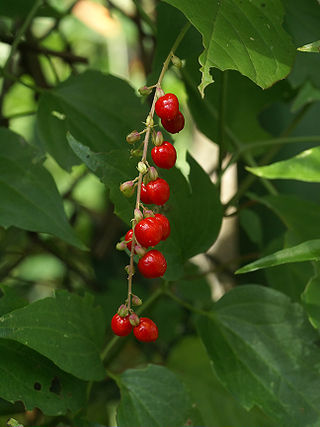Rivina humilis
Species of flowering plant From Wikipedia, the free encyclopedia
Rivina humilis is a species of flowering plant in the family Petiveriaceae. It was formerly placed in the pokeweed family, Phytolaccaceae.[2] It can be found in the southern United States, the Caribbean, Central America, and tropical South America. Common names include dogblood, pigeonberry,[1] rougeplant,[1] baby peppers,[3] bloodberry,[1] and coralito.[1] The specific epithet means "dwarfish" or "lowly" in Latin, referring to the plant's short stature.[4]
| Rivina humilis | |
|---|---|
 | |
| Scientific classification | |
| Kingdom: | Plantae |
| Clade: | Tracheophytes |
| Clade: | Angiosperms |
| Clade: | Eudicots |
| Order: | Caryophyllales |
| Family: | Petiveriaceae |
| Genus: | Rivina |
| Species: | R. humilis |
| Binomial name | |
| Rivina humilis | |
| Synonyms | |
|
Rivina laevis L.[1] | |
Description
Pigeonberry is an erect, vine-like[5] herb,[3] reaching a height of 0.4–2 m (1.3–6.6 ft).[5] The leaves of this evergreen perennial[6] are up to 15 cm (5.9 in) long and 9 cm (3.5 in) wide, with a petiole 1–11 cm (0.39–4.33 in) in length. Flowers are on racemes 4–15 cm (1.6–5.9 in) long with a peduncle 1–5 cm (0.39–1.97 in) in length and pedicels 2–8 mm (0.079–0.315 in) long. Sepals are 1.5–3.5 mm (0.059–0.138 in) in length and white or green to pink or purplish.[5] The fruit is a glossy, bright red berry[4] 2.5–5 mm (0.098–0.197 in) in diameter.[5]

Habitat
Rivina humilis can be found in forests, thickets, shell middens, hammocks, roadsides, and disturbed areas at elevations from sea level to 1,700 m (5,600 ft).[5] It requires less than partial sun and is tolerant of full shade. It is also tolerant of salt spray and saline soils.[6]
It is considered invasive in New Caledonia, where it was likely introduced in 1900.[7] It is considered a weed in Queensland, Australia where it has naturalised, and is also naturalised on Cocos Islands, Réunion, Norfolk Island, Fiji, Tonga, French Polynesia, Hawaii, India and the Galapagos Islands.[8]
Uses
Pigeonberry is cultivated as an ornamental in warm regions throughout the world[5] and is valued as a shade-tolerant groundcover.[9] It is also grown as a houseplant[10] and in greenhouses.[5]
The juice made from the berries was used as a dye and ink at one time. The berries contain a pigment known as rivianin or rivinianin,[4] which has the IUPAC name 5-O-β-D-Glucopyranoside, 3-sulfate, CAS number 58115-21-2, and molecular formula C24H26N2O16S.[11] It is very similar to betanin, the pigment found in beets.[4] The fruit also contains the betaxanthin humilixanthin.[12]
The juice of the berries have been tested in male rats and are reported to be safe to consume.[13]
Ecology
R. humilis is a host plant for the caterpillars of Goodson's greenstreak (Cyanophrys goodsoni)[14]
References
External links
Wikiwand - on
Seamless Wikipedia browsing. On steroids.
